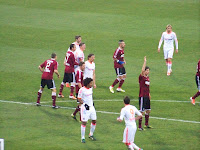 Eisenach
Eisenach Whenever we can, we break up the 8 hr drive to Andrew's parents' house, doubly so this Christmas with Andrew's arm still being in a cast which meant I got to do all the driving. So we chose Eisenach because 1) it was on the way! 2) Johann Sebastian Bach was born there and Luther lived there and 3) it's yet another charming German city.
 Das Bachhaus is a fantastic example how to marry old and new. His childhood home has been amazingly restored due to 600 years of time and then the bombing in WWII. Hmm, I wonder who did that?
Das Bachhaus is a fantastic example how to marry old and new. His childhood home has been amazingly restored due to 600 years of time and then the bombing in WWII. Hmm, I wonder who did that?The renovated sections have been connected to a sleek high tech museum showcasing a wonderful variety of his works, contemporary books and instruments.

 This little treasure is a glass harmonica, invented in 1760, and played by rotating a pedal and wetting your finger! Mozart, Beethoven, Strauss and Wagner also wrote pieces specifically for this instrument.
This little treasure is a glass harmonica, invented in 1760, and played by rotating a pedal and wetting your finger! Mozart, Beethoven, Strauss and Wagner also wrote pieces specifically for this instrument.Emma liked this Taschengeige (pocket violin) which was used by dance teachers. They could easily stow it in their pocket, show their students the correct steps and then play the piece again.
 |
Now, I'm no cartographer, but I would guess this world map is not to scale...
Notice the location of the black and white keys - ivory was known but incredibly expensive.
Here's a little nugget: Bach (1685-1750) and a friend walked to Hamburg in search of work after they finished their schooling. Also, Bach had 20 children! He had seven children with his first wife, his cousin, and thirteen children with his second. Only 10 in total survived childhood.
 |
| Luther Statue |
Martin Luther in a nutshell: (1483 – 1546) German monk, priest, professor of theology and major player in the Protestant Reformation. He strongly disputed many practices in the Catholic church's including the claim that sins could be "paid off" by purchasing Indulgences in his Ninety-Five Theses which he nailed to the front door of the castle church in Wittenberg in 1517. His refusal to retract all this got him excommunicated.
With a price on his head, he was "kidnapped" by Frederick the Wise of Saxony and hidden away for a year at Wartburg Castle.
 |
| Eisenach's Wartburg Castle |














